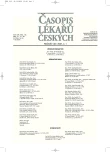-
Medical journals
- Career
Effect of Hypolipidemic Treatment on the Composition of Bile and the Risk or Cholesterol Gallstone Disease
Authors: A. Žák; M. Zeman; K. Hrubant; M. Vecka; E. Tvrzická
Authors‘ workplace: IV. interní klinika 1. LF UK a VFN, Praha
Published in: Čas. Lék. čes. 2007; 146: 24-34
Category: Review Article
Overview
Obesity, diabetes mellitus type 2 and dyslipidemia, characterized by hypertriglyceridemia and low HDL-cholesterol levels, are risk factors for cholesterol gallstone disease. The common denominator of above-mentioned states is insulin resistance. Hypolipidemic treatment significantly influences not only the biliary lipid composition, but also other etiopathogenetic mechanisms of the disease. Three principal defects are involved in gallstone formation – cholesterol supersaturation, accelerated nucleation, and gallbladder dysmotility. The degree of cholesterol saturation in gallbladder bile is the most important predictor of cholesterol crystal formation. Cholesterol, lecithin and bile acids are the major components in bile. According to the molar ratios of the three main components, simple or mixed micelles, unstable unilamellar or multilamellar vesicles are formed in the bile. The cholesterol supersaturation of the gallbladder bile and cholesterol crystal formation from the unstable multilamellar vesicles initiates the onset of cholesterol cholelithiasis. The pool of unesterified cholesterol is the source for VLDL synthesis; together with HDL-cholesterol, it is also the source for cholesterol secretion into the bile. The main metabolic products of cholesterol degradation are bile acids, which are synthesized predominantly from LDL-cholesterol. The rate of the production of primary bile acids is principally regulated by cholesterol 7α-hydroxylase (CYP7A1). The treatment of dyslipidemia with niacin and resins does not influence the saturation of bile with cholesterol or the incidence of cholelithiasis. The effects of ezetimibe in human patients with the respect of cholesterol cholelithiasis have not been published. The fibrate treatment is associated with increased cholesterol saturation of bile due to inhibition of CYP7A1 activity, enhanced flux of cholesterol via HDL and increased secretion of cholesterol into bile. The clinical studies describe cholesterol supersaturation in bile and increased frequency of cholelithiasis as well. The administration of pravastatin and simvastatin led to reduced cholesterol saturation indexes. The patients with endogenous hypertriglyceridemia and low HDL-cholesterol being administered with polyunsaturated fatty acids of n-3 family had decreased cholesterol concentration in bile. Other authors described beneficial effect of fish oil on the biliary cholesterol nucleation time, improvement of gallbladder sensitivity to cholecystokinin and the prevention of cholesterol gallstone formations caused by rapid weight loss.
Key word:
cholesterol cholelithiasis, dyslipidemia, secretion of bile lipids, bile saturation with cholesterol, risk of cholelithiasis, hypolipidemic treatment.
Labels
Addictology Allergology and clinical immunology Angiology Audiology Clinical biochemistry Dermatology & STDs Paediatric gastroenterology Paediatric surgery Paediatric cardiology Paediatric neurology Paediatric ENT Paediatric psychiatry Paediatric rheumatology Diabetology Pharmacy Vascular surgery Pain management Dental Hygienist
Article was published inJournal of Czech Physicians

-
All articles in this issue
- Needfulness and Mission of Health Edu
- To the Fourties Anniversary of the Pancreatic Transplantation
- Lower Dyspeptic Syndrome Recommended Diagnostic and Therapeutic Practice for General Practitioners 2006
- Effect of Hypolipidemic Treatment on the Composition of Bile and the Risk or Cholesterol Gallstone Disease
- Orthopaedic Treatment of Osteolytic Lesions in Long Bones of Multiple Myeloma Patients
- Postoperative Pulmonary Thromboembolism and Nosocomial Pneumonias: Differential Diagnosis
- Prognostic Impact of Matrix Metalloproteinases 2,9, and 11 in Stromal Cells Stage I Non-small Cell Lung Cancer
- Cardiac Surgery Operations and Their Influence on Serum Level of Antiinflammatory Cytokine Interleukin-10
- Cohort of Lymphedema Patients Followed at the Lymphology Centre of the Dermatovenerologcal Clinic of the 2nd Faculty of Medicine University Hospital Na Bulovce Prague in Years 2000 to 2005 A Retrospective Study
- The p53 Positivity in Non-tumor Mucosa in Patients with Superficial Urinary Bladder Cancer
- HIV/AIDS and Pathology in Blood Count
- Incidence of Hiatal Hernias in the Current Endoscopic Praxis
- A Rare Complication of Acute Lymphoblastic Leukaemia in Young Patients
- Incidence of Delirium Tremens in the Czech Republic: A Rapid Increase
- Journal of Czech Physicians
- Journal archive
- Current issue
- Online only
- About the journal
Most read in this issue- Lower Dyspeptic Syndrome Recommended Diagnostic and Therapeutic Practice for General Practitioners 2006
- HIV/AIDS and Pathology in Blood Count
- Incidence of Hiatal Hernias in the Current Endoscopic Praxis
- Postoperative Pulmonary Thromboembolism and Nosocomial Pneumonias: Differential Diagnosis
Login#ADS_BOTTOM_SCRIPTS#Forgotten passwordEnter the email address that you registered with. We will send you instructions on how to set a new password.
- Career

